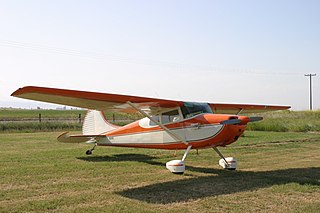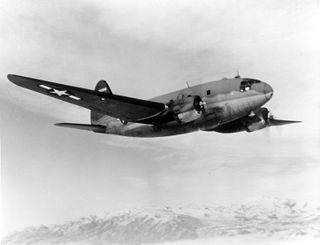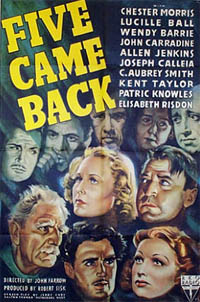
The Cessna 170 is an American light, single-engined, general aviation aircraft produced by the Cessna Aircraft Company between 1948 and 1956.

The Curtiss C-46 Commando is a twin-engine transport aircraft derived from the Curtiss CW-20 pressurised high-altitude airliner design. Early press reports used the name "Condor III", but the Commando name was in use by early 1942 in company publicity. It was used as a military transport during World War II by the United States Army Air Forces and also the U.S. Navy/Marine Corps, which used the designation R5C. The C-46 served in a similar role to its Douglas-built counterpart, the C-47 Skytrain, but it was not as extensively produced as the latter.
The Lockheed Model 10 Electra is an American twin-engined, all-metal monoplane airliner developed by the Lockheed Aircraft Corporation in the 1930s to compete with the Boeing 247 and Douglas DC-2. The type gained considerable fame as one was flown by Amelia Earhart on her ill-fated around-the-world expedition in 1937.

The Yakovlev Yak-12 is a light multirole STOL aircraft used by the Soviet Air Force, Soviet civilian aviation and other countries from 1947 onwards.

The Boeing C-108 Flying Fortress was an American transport aircraft used during World War II. Four were converted from B-17 Flying Fortress heavy bombers.

The Curtiss P-60 was a 1940s American single-engine single-seat, low-wing monoplane fighter aircraft developed by the Curtiss-Wright company as a successor to their P-40. It went through a lengthy series of prototype versions, eventually evolving into a design that bore little resemblance to the P-40. None of these versions reached production.

The Northrop Alpha was an American single-engine, all-metal, seven-seat, low-wing monoplane fast mail/passenger transport aircraft used in the 1930s. Design work was done at the Avion Corporation, which in 1929, became the Northrop Aircraft Corporation based in Burbank, California.

Five Came Back is a 1939 American black-and-white melodrama from RKO Radio Pictures produced by Robert Sisk, directed by John Farrow, written by Jerry Cady, Dalton Trumbo, and Nathanael West, and starring Chester Morris and Lucille Ball. The film was photographed by cinematographer Nicholas Musuraca. Although considered a B movie, the positive notices received by Ball helped launch her phenomenal career as an A-list actress. Five Came Back is considered a precursor of the disaster film genre. The supporting cast features Wendy Barrie, John Carradine, C. Aubrey Smith, Kent Taylor, and Patric Knowles.

The Aichi E16A Zuiun was a two-seat reconnaissance seaplane operated by the Imperial Japanese Navy during World War II.

The Vought V-173 "Flying Pancake" was an American experimental test aircraft built as part of the Vought XF5U program during World War II.

The Fairchild 71 was an American high-wing monoplane passenger and cargo aircraft built by Fairchild Aircraft and later built in Canada by Fairchild Aircraft Ltd. (Canada) for both military and civilian use as a rugged bush plane.

The Fleetwings BT-12 Sophomore, also known by the company designation Model 23, was a 1940s all-metal basic training monoplane built by Fleetwings for the United States Army Air Forces. Only 24 production examples of the type were built before the contract was cancelled.

The Lockheed XC-35 is a twin-engine, experimental pressurized airplane. It was the second American aircraft to feature cabin pressurization. It was initially described as a 'supercharged cabin' by the Army. The distinction of the world's first pressurized aircraft goes to a heavily modified Engineering Division USD-9A which flew in the United States in 1921. The XC-35 was a development of the Lockheed Model 10 Electra that was designed to meet a 1935 request by the United States Army Air Corps for an aircraft with a pressurized cabin.

The Stout Skycar was a series of four one-off American light aircraft of the 1930s.

The Kreider-Reisner XC-31 or Fairchild XC-31 was an American single-engined monoplane transport aircraft of the 1930s designed and built by Kreider-Reisner. It was one of the last fabric-covered aircraft tested by the U.S. Army Air Corps. Designed as an alternative to the emerging twin-engined transports of the time such as the Douglas DC-2, it was evaluated by the Air Corps at Wright Field, Ohio, under the test designation XC-941, but rejected in favor of all-metal twin-engined designs.

The Hamilton H-45 and H-47 were six-passenger-seat, all-metal, high-wing monoplanes powered by single Pratt & Whitney radial engines. They were built for passenger and mail-carrying work in the US in the late 1920s.

The Aeromarine AM-1 was a biplane built to pursue a US Air Mail Service requirement for a nighttime transport.

Daredevils of the Clouds is a 60-minute 1948 drama film, directed by George Blair and produced by Republic Pictures. The film stars Robert Livingston, Mae Clarke and James Cardwell. Daredevils of the Clouds depicts bush pilot flying in northern Canada.

Wings Over the Pacific is a 60-minute 1943 drama film, directed by Phil Rosen and starring Inez Cooper, Edward Norris and Montagu Love. Produced by Monogram Pictures, the film depicts an island community in the South Pacific caught up in World War II.

The Vega Model 2 Starliner was a prototype five-seat feeder airliner produced by the Vega Airplane Company, a subsidiary of Lockheed. It was designed to be powered by an unusual powerplant, consisting of two Menasco piston engines coupled together to drive a single propeller. A single example was built, flying in 1939, but no production followed.




















